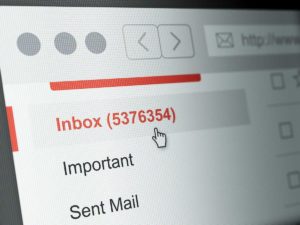 This past weekend, I spent a couple of hours talking with new teachers during a Communication Confidence Boosters workshop and “Throw Your Communication Challenges At Me” Q&A session.
This past weekend, I spent a couple of hours talking with new teachers during a Communication Confidence Boosters workshop and “Throw Your Communication Challenges At Me” Q&A session.
First, I was absolutely floored by the number of teachers participating in their own professional development after what was likely the first week of launching distance education for many of them. They are true rockstars!
Next, when one teacher asked how she could organize and prioritize the “hundreds of district emails” in her in-box—and the affirmation of the other teachers who related—I realized that internal communication in a lot of organizations is likely looking like my personal email in-box: like a bunch of people yelling at me telling me that their message is important.
Although I gave this teacher some advice on how to filter and organize her in box so that she could at least see parent emails first—and then create priorities and timelines around when she could check the other emails—the truth is, your internal audiences should not need to spend hours setting up email filters and in box folders to organize and prioritize your messages. That’s a late 1990’s/early 2000’s thing. Don’t get me wrong–organizing your email inbox is a must, however, with your internal communications, your organization should be doing this through integrated, organized, strategic and concise messaging.
Remember what I’ve said before? More communication is not better. More communication means that you’re making your audience choose what they want to read and open.
Better communication filters out the noise and hones in on the most important messages. More communication means that you’re asking audience members to read to wordy messages, long videos and poorly messaged content to determine whether what they read and saw was important, or if it was just a “fluffy message filler.”
Better communication puts the information succinctly in one place, and prioritizes the messaging.
So how can you accomplish this? Simply–put the information in one spot for the employee. And keep messages brief and to-the-point. Here are a few suggestions:
Employee Newsletter
An employee newsletter is a great way to put all the information you need to send to employees in one place.
- Frequency: Aim to send the newsletter 1-2 times a week.
- Length: Your newsletter should be no longer than 1-1.5 printed pages. The key is to hone in on key information. Provide links to more detailed information on your website, where necessary, but not in every single story.
- Format: NOT a pdf download. If you make people open an email, then download a pdf to read your newsletter, you’ve lost at least 50% of your audience. There are several online email programs that provide easy-to-use, attractive formats. Constant Contact and MailChimp are a couple of popular email programs. And, depending on the number of email address in your organization, you may even be able to use their free versions. These programs also allow you to look at open rates, and link click through rates, which is a wonderful way to track how many of your emails are being opened and which links people are clicking on for more information.
- Include a couple of pictures (not clip art, but pictures of real employees, or from school sites) where relevant.
- Because of the frequency, it’s key to ensure that the information is timely, and to organize information around the timing of the newsletter’s delivery.
Employee Intranet
Over the past few years, there has been a small rise in the use of employee intranets (closed internal communications network), though the use of Google Drive has also served this need.
- Pros: It’s streamlined. An employee intranet gives your employees one place to access shared drives and information. You can post important employee-only calendar events (versus posting them on your public-facing events calendar), reminders that can be integrated with email, and notifications. Many organizations have multiple ways that employees must obtain this information, and anything that requires an employee to log in to multiple platforms to obtain information basically reduces the chance that the employee will log in and see that information. So, if you want success with your employee interfaces, then look at one place they need to log in.
- Cons: They can be costly and somewhat time consuming to set up. However, the employee time saved and the opportunity to ensure that they are seeing and sharing your messages is worth the up front costs. Here’s a link to a great article that outlines Employee Intranet: 40 Reasons Why Every Business Needs One.
Employee Texts
If you have employees who do not regularly use email, but do have an employer-issued phone, consider sending brief texts intended just for those employees. Obviously, they don’t need all the tech-related updates relevant to distance education, but they still need to be kept in the loop.
Employee Phone Messages
You may have some employees who are not working right now who usually receive information via district mail or on a bulletin board. It’s important to keep them engaged and informed about important matters. Utilize your organization’s phone messaging program (if you have one) or ask directors and managers to reach out to these employees individually to provide them the latest updates (and to check in on them if they’re personally calling each employee).
Need help setting up strategic and streamlined internal communications, or need some advice on how to do so? Give us a call at 916.673.8868 or send us an email. We’ll get you up and going within the day on an email communication, employee phone messages and texts, or can refer you to great employee intranet vendors.

